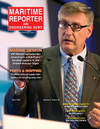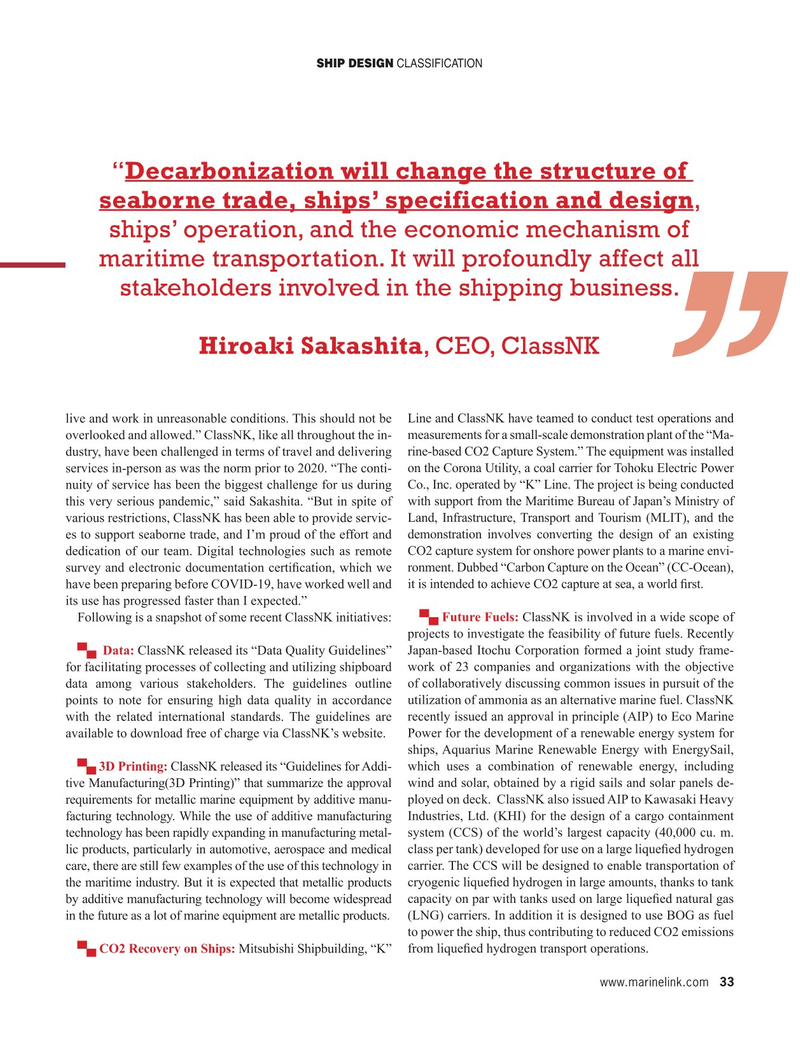
Page 33: of Maritime Reporter Magazine (September 2021)
The Marine Design Edition
Read this page in Pdf, Flash or Html5 edition of September 2021 Maritime Reporter Magazine
SHIP DESIGN CLASSIFICATION “Decarbonization will change the structure of seaborne trade, ships’ specification and design, ships’ operation, and the economic mechanism of maritime transportation. It will profoundly affect all stakeholders involved in the shipping business.
Hiroaki Sakashita, CEO, ClassNK live and work in unreasonable conditions. This should not be Line and ClassNK have teamed to conduct test operations and overlooked and allowed.” ClassNK, like all throughout the in- measurements for a small-scale demonstration plant of the “Ma- dustry, have been challenged in terms of travel and delivering rine-based CO2 Capture System.” The equipment was installed services in-person as was the norm prior to 2020. “The conti- on the Corona Utility, a coal carrier for Tohoku Electric Power nuity of service has been the biggest challenge for us during Co., Inc. operated by “K” Line. The project is being conducted this very serious pandemic,” said Sakashita. “But in spite of with support from the Maritime Bureau of Japan’s Ministry of various restrictions, ClassNK has been able to provide servic- Land, Infrastructure, Transport and Tourism (MLIT), and the es to support seaborne trade, and I’m proud of the effort and demonstration involves converting the design of an existing dedication of our team. Digital technologies such as remote CO2 capture system for onshore power plants to a marine envi- survey and electronic documentation certi? cation, which we ronment. Dubbed “Carbon Capture on the Ocean” (CC-Ocean), have been preparing before COVID-19, have worked well and it is intended to achieve CO2 capture at sea, a world ? rst.
its use has progressed faster than I expected.”
Following is a snapshot of some recent ClassNK initiatives: ¯_ Future Fuels: ClassNK is involved in a wide scope of projects to investigate the feasibility of future fuels. Recently ¯_ Data: ClassNK released its “Data Quality Guidelines” Japan-based Itochu Corporation formed a joint study frame- for facilitating processes of collecting and utilizing shipboard work of 23 companies and organizations with the objective data among various stakeholders. The guidelines outline of collaboratively discussing common issues in pursuit of the points to note for ensuring high data quality in accordance utilization of ammonia as an alternative marine fuel. ClassNK with the related international standards. The guidelines are recently issued an approval in principle (AIP) to Eco Marine available to download free of charge via ClassNK’s website. Power for the development of a renewable energy system for ships, Aquarius Marine Renewable Energy with EnergySail, ¯_ 3D Printing: ClassNK released its “Guidelines for Addi- which uses a combination of renewable energy, including tive Manufacturing(3D Printing)” that summarize the approval wind and solar, obtained by a rigid sails and solar panels de- requirements for metallic marine equipment by additive manu- ployed on deck. ClassNK also issued AIP to Kawasaki Heavy facturing technology. While the use of additive manufacturing Industries, Ltd. (KHI) for the design of a cargo containment technology has been rapidly expanding in manufacturing metal- system (CCS) of the world’s largest capacity (40,000 cu. m. lic products, particularly in automotive, aerospace and medical class per tank) developed for use on a large lique? ed hydrogen care, there are still few examples of the use of this technology in carrier. The CCS will be designed to enable transportation of the maritime industry. But it is expected that metallic products cryogenic lique? ed hydrogen in large amounts, thanks to tank by additive manufacturing technology will become widespread capacity on par with tanks used on large lique? ed natural gas in the future as a lot of marine equipment are metallic products. (LNG) carriers. In addition it is designed to use BOG as fuel to power the ship, thus contributing to reduced CO2 emissions ¯_ CO2 Recovery on Ships: Mitsubishi Shipbuilding, “K” from lique? ed hydrogen transport operations.
www.marinelink.com 33
MR #9 (18-33).indd 33 9/7/2021 4:03:38 PM

 32
32

 34
34
